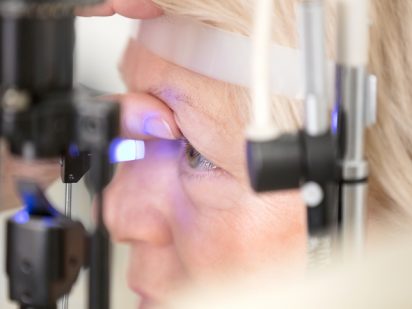The lens of the eye is a very important part of vision.
Through the lens, light rays are refracted, helping a person see clearly. While clear at birth, over time this lens loses its clarity.
A cataract is the clouding of the eye’s natural lens. People who suffer from cataracts often feel as though they are looking through a foggy or clouded window.
According to the American Academy of Ophthalmology, symptoms of cataracts include:
• Having blurry vision
• Seeing double
• Being extra sensitive to light
• Having trouble seeing well at night or needing more light when you read
• Seeing bright colors as faded or yellow instead
“They simply can’t see what they used to see,” said Darren Hill, MD, an ophthalmologist with Trinity Health. “Their vision is blurry, they have more difficulty reading even with their glasses on, and they need more and more light for reading and activities.”
Cataracts are “very common,” Dr. Hill said, adding that most common forms develop in people who are older. They also develop “faster in people who smoke or have underlying health conditions like diabetes.”
However, there are types that can develop in younger patients, sometimes even without underlying health conditions. “Most people would benefit from cataract surgery by the end of their lives,” Dr. Hill said, adding that by age 50, “almost everyone has some degree of cataract in their eyes.”
According to the National Eye Institute, more than half of all Americans age 80 years and older either have cataracts or have had surgery to get rid of cataracts.
There are other causes of cataracts, including:
• Having parents, siblings, or other family members who have cataracts
• Having certain medical problems, such as diabetes
• Smoking
• Having had an eye injury, eye surgery, or radiation treatments on your upper body.
• Having spent a lot of time in the sun, especially without sunglasses that protect eyes from damaging ultraviolet rays
• Using certain medications such as corticosteroids, which may cause early formation of cataracts
In its early stage, the cloudiness in vision caused by cataracts may affect only a small part of the eye’s lens; the minuteness may not even present as a visual problem. As the cataract worsens, it may lead to signs and symptoms that affect daily activities. Some early symptoms of cataracts can be controlled with new glasses, lighting, magnification, and other visual aids. However, surgery is the only definitive treatment. Surgery is recommended when the cataract has progressed to the point where it is disrupting your everyday activities such as driving and reading.
Surgery involves moderate sedation in the operating room, with the administration of a series of eye drops to make the eye “numb and comfortable,” Dr. Hill explained. Once the patient is relaxed, “we essentially make tiny incisions in the eye and physically remove the cloudy lens and replace it with a permanent artificial lens.” There are several different lens options to choose from, and the newest technology lenses offer the potential to be completely glasses-free after cataract surgery. “We now have the lens technology to offer the cure for glasses, and the technology just keeps getting better,” says Dr. Hill.
The surgery takes about 15 minutes. Following the surgery, the wounds heal quickly. The patient then wears an eyepatch overnight. “People usually feel great the next day and are returning to full activity in less than one week,” he noted. “Vision often has settled by that time.”
If you see any visible symptoms of cataracts, Dr. Hill suggests making an appointment with your optometrist “to see if this can be corrected with glasses. If glasses can’t help, the optometrist would refer the patient to an ophthalmologist.”
Trinity Health’s optometrists include Jill Martinson-Redekopp, OD, Brad Schimke, OD, and Sierra Unruh, OD, who are based at Trinity Health Plaza 16, 2815 16th St SW, Minot; for appointments, call 701-852-3937. For appointments at Trinity Health Western Dakota, 1321 W Dakota Pkwy, Williston, call 701-572-7641.




